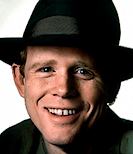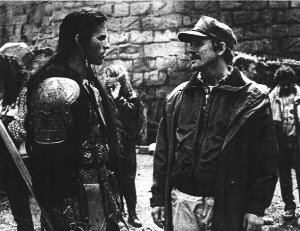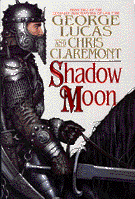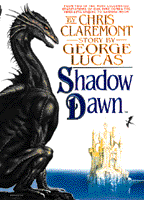

|
The origins of the Willow movie (and its offspring, the Shadow Moon
fantasy series) can be traced back to the early 70's. According to George
Lucas, this was about the time when he came up with the story for
Willow. Unfortunately, Lucas' vision for the film included visual
effects that would not be developed for at least another decade. Even if
the technology did exist, it would undoubtedly be very expensive, and Lucas
did not yet have a big enough name in the film industry to gain access to
that kind of money. Yielding to these insurmountable obstacles, Lucas spent
his time working on other projects (aka American Graffiti and the
Star Wars Trilogy), and put Willow on the back burner.
Cut to the mid-eighties. With the Star Wars and Indiana Jones movies under his belt, Lucas had both single-handedly advanced the special effects industry light-years and established himself as one of the biggest names in Hollywood. So, he turned his attention back to Willow. |
|

|
One of Lucas' first
moves was to call in his old friend Ron Howard to direct. Howard had acted
in Lucas' American Graffiti and since then had established himself
as a successful director, helming such films as Splash and
Cocoon. Lucas also brought in Bob Dolman (screenwriter for WKRP
in Cincinnati) to pen the script, and set his own special effects company
(Industrial Light and Magic) to work on preproduction.
|
 A slew of talented actors were cast in the film.
Warwick Davis (Wicket the Ewok from Return of the Jedi) was selected
for the title role. Val Kilmer (seen right, talking with director Howard
on the set) was cast as Willow's renegade ally Madmartigan, and Joanne Whalley
as Madmartigan's adversary-turned-lover Sorsha. (Their on-screen romance
quickly flared up off-camera, and the couple was married soon after production.)
Jean Marsh, who had just finished up playing the evil sorceress in Lucas'
Return to Oz, was cast as the evil sorceress-queen Bavmorda, and comedians
Rick Overton and Kevin Pollack were cast as Willow's brownie sidekicks, Franjean
and Rool. Patricia Hayes, Pat Roach, Gavan O'Herlihy, and veteran dwarf actor
Billy Barty rounded out the cast. A slew of talented actors were cast in the film.
Warwick Davis (Wicket the Ewok from Return of the Jedi) was selected
for the title role. Val Kilmer (seen right, talking with director Howard
on the set) was cast as Willow's renegade ally Madmartigan, and Joanne Whalley
as Madmartigan's adversary-turned-lover Sorsha. (Their on-screen romance
quickly flared up off-camera, and the couple was married soon after production.)
Jean Marsh, who had just finished up playing the evil sorceress in Lucas'
Return to Oz, was cast as the evil sorceress-queen Bavmorda, and comedians
Rick Overton and Kevin Pollack were cast as Willow's brownie sidekicks, Franjean
and Rool. Patricia Hayes, Pat Roach, Gavan O'Herlihy, and veteran dwarf actor
Billy Barty rounded out the cast.
Columbia Pictures spent $40 million on Willow, which at the time was quite a bit of money. The amount of publicity at the film's opening stood as testimony to the studio's expectations: trailers were broadcast around the clock, and soon the American public was knee-deep in everything from Willow trading cards to Willow baseball caps. (See the merchandise page for more information.) Even without the promotional extravaganza, Willow had all the makings of another blockbuster for George Lucas: a creative story, breathtaking special effects, solid acting . . . the list goes on and on. And yet, somehow, the movie flopped. It was met by mediocre reviews by critics, which may have been the prime reason audiences stayed away from Willow. Whatever the reason, the film was a financial disaster, grossing only $57 million. |
|

|
George Lucas once said he was afraid the Willow
saga was too big for one movie. Well, the economic failure of Willow
collapsed any notions of expanding the story into more movies, and by all
rights the saga should have ended there. Thankfully, Lucas refused to let
Willow die that easily. In August, 1995, Bantam/Doubleday released Shadow
Moon. The novel, written by Lucas and Chris Claremont (of X-Men
fame), presented the continuing adventures of Willow Ufgood, albeit in a
different format. And, unlike the Willow movie, Shadow Moon
was a financial success.
|
 The latest addition to the ever-unfolding "Story
Behind the Saga" occurred last January, with the publication of Shadow
Dawn. This first sequel to Shadow Moon was penned entirely by
Claremont (thought Lucas gets credit for the story), and will not
be the last; Shadow Star, the final volume of the trilogy, is coming soon. The latest addition to the ever-unfolding "Story
Behind the Saga" occurred last January, with the publication of Shadow
Dawn. This first sequel to Shadow Moon was penned entirely by
Claremont (thought Lucas gets credit for the story), and will not
be the last; Shadow Star, the final volume of the trilogy, is coming soon.
|
|
Related Sites:
The Internet Movie Database
Willow Entry
George
Lucas Homepage
Chris Claremont Homepage
Val
Kilmer Multimedia Homepage
Planet Kilmer
Joanne Whalley
Homepage